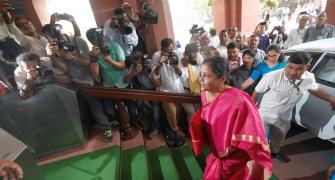Nirmala Sitharaman has designed the revenue mix in such a way that while Centre’s share in taxes would grow a massive 25 per cent, states’ share would grow a dismal 6 per cent.
Illustration: Uttam Ghosh/Rediff.com

The Union Budget presented on Friday, has put brakes on some funds that would have gone to states, courtesy the change in the revenue mix.
The share of states in gross tax revenue (devolution) and the funds they get for specified purposes will grow slower this year due to drop in revenue projections of taxes which fall in the divisible pool of taxes, more incremental collection from cess and surcharge, and the conditional nature of Finance Commission grants as well as centrally sponsored schemes (CSS).
According to Finance Commission (FC) formula, 42 per cent of the divisible pool of tax revenue collected by the Centre has to be distributed to states.
Tax revenue collected as cess or surcharge, and the cost of tax collection remains out of the divisible pool.
In addition to this fiscal devolution, Centre grants money to states for strengthening urban and rural local bodies, to contain their revenue deficit and on schemes such as Pradhan Mantri Gram Sadak Yojana.
The sum devolved to states are untied funds, and states can spend them according to their discretion.
Most of the other transfers are tied funds, to be used only for the specified purpose.
The share of devolved funds in total transfer to states has come down from 62 per cent in 2017-18 to 60 per cent in 2019-20 (BE).
Consider the disparity in sharing of gross tax revenue between Centre and states.
Arun Jaitley’s 2018-19 budget projected a 19 per cent growth in net tax revenue to the Centre, while a 17 per cent growth in states’ share.
But as the financial year ended, states’ share grew 13 per cent over 2017-18, and Centre’s share rose merely 6 per cent.
Part reason for this could be healthy revenues from corporation tax and customs revenue.
Facing poor revenue mobilisation in 2018-19, Piyush Goyal’s Interim Budget 2019-20 (presented on February 1) projected Centre’s net tax revenue to grow 15 per cent, and states’ share to grow slower at 11 per cent.
Cut to July, Nirmala Sitharaman has designed the revenue mix in such a way that while Centre’s share in taxes would grow a massive 25 per cent, states’ share would grow a dismal 6 per cent.
The reason: the estimate from divisible pool of taxes was slashed by nearly Rs 1.4 trillion compared to the Interim Budget, as revenue projections from personal income tax and goods and services tax (CGST) have been slashed.
However, the reason for lower growth in states’ share is the accounting method and high base effect, said Ritwik Pandey, joint secretary for revenue in the ministry of finance.
He said that the devolution to states happens on the basis of revised estimates (RE), regardless of the pre-actuals presented by the Controller General of Accounts.
“Though revenue according to pre-actuals is lower than the RE, the amount devolved to states is as per the revised estimates, which are way higher.
"This has overestimated the devolution amount for FY19, which will get revised in FY20,” he said.
The extra amount paid to states in FY19 will be subtracted from the devolution amount of FY20, which will further reduce the growth in devolution.
However, the nature of taxes too reduced the devolution amount for FY20.
The downward revisions in revenue estimates has been from those sources which are a part of the divisible pool: personal income tax and goods and services tax, while customs and corporation tax have seen marginal upward revisions.
This chipped away nearly Rs 1.4 trillion from the divisible pool of taxes.
Excise revenue was upscaled by Rs 40,000 crore, but this will come in the form of cess.
Similarly, official sources quote a growth of Rs 12,000 crore from increased surcharge on incomes of the ultra-rich.
The Centre has also reduced the speed of funds going to state via the remaining channels: Finance Commission transfers, revenue deficit grants and CSS. A 24 per cent growth in FC transfers proposed in the Interim Budget has been revised down to 14 per cent in Sitharaman’s full Budget.
FC grants have been cut by 8.6 per cent to Rs 1.2 trillion in the full budget compared to Rs 1.31 trillion during interim budget, with a steep cut of Rs 8,000 crore for grant to rural local bodies.
However transfers under CSS has gone up marginally by Rs 5,000 crore.
Under various CSS, both Centre and respective states spend in a specified ratio.
While Centre’s net tax revenue (post devolution to states) would grow 25 per cent this year, spending on CSS would grow only nine per cent.
The Centre has reduced the growth in the remaining channels of transfers to states.
A 24 per cent growth in FC transfers proposed in the Interim Budget has been revised down to 14 per cent in Sitharaman’s full budget.
“Bulk of non-devolution grants from the Centre to states are linked to expenditure being incurred by the states, or to reforms undertaken by them in some cases.
"Of late, revenue deficit grants have stood out as a major source of untied grants, meaning, with no specified end use,” Aditi Nayar, chief economist at Icra, said.










